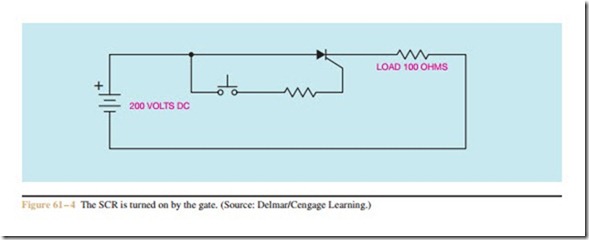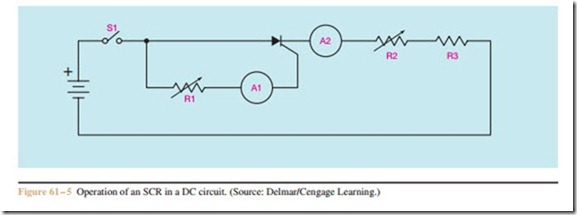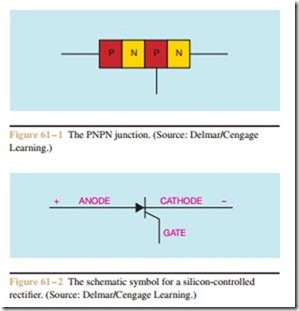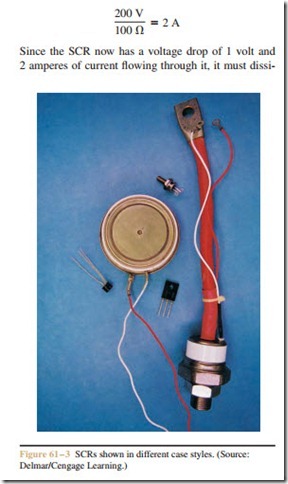The silicon-controlled rectifier (SCR) is often referred to as a PNPN junction because it is made by joining four schematic symbol for the SCR is shown in Figure 61– 2. Notice that the symbol for the SCR is the same as the symbol for the diode except that a gate lead has been added. Case styles for SCRs are shown in Figure 61– 3.
The SCR is a member of a family of devices known as thyristors. Thyristors are digital devices in that they have only two states, on and off. The SCR is used when it is necessary for an electronic device to control a large amount of power. For example, assume that an SCR has been connected in a circuit as shown in Figure 61– 4. When the SCR is turned off, it will drop the full voltage of the circuit, and 200 volts will appear across the an- ode and cathode. Although the SCR has a voltage drop of 200 volts, there is no current flow in the circuit. The SCR does not have to dissipate any power in this condition (200 V X 0 A = 0 W). When the push button is pressed, the SCR turns on, producing a voltage drop
across its anode and cathode of about 1 volt. The load resistor limits the circuit current to 2 amperes:
pate 2 watts of heat (1 V X 2 A = 2 W). Notice that although the SCR is dissipating only 2 watts of power, it is controlling 400 watts of power.
The SCR in a DC Circuit
When an SCR is connected in a DC circuit as shown in Figure 61– 4, the gate will turn the SCR on, but it will not turn the SCR off. To turn the anode-cathode section of the SCR on, the gate must be connected to the same polarity as the anode. Once the gate has turned the SCR on, the SCR will remain on until the current flowing through the anode-cathode section drops to a low enough level to permit the device to turn off. The amount of current required to keep the SCR turned on is called the holding current.
In Figure 61– 5, assume that resistor R1 has been adjusted to its highest value and resistor R2 has been adjusted to its lowest or 0 value. When switch S1 is closed, no current will flow through the anode-cathode section of the SCR because resistor R1 prevents the amount of current needed to trigger the device from flowing through the gate-cathode section of the SCR. If the value of resistor R1 is slowly decreased, current flow through the gate-cathode section will slowly in- crease. When the gate reaches a certain level (assume 5 mA for this SCR) the SCR will fire, or turn on. When the SCR fires, current will flow through the anode- cathode section and the voltage drop across the device will be about 1 volt. Once the SCR is turned on, the gate has no control over the device. It could be dis- connected from the anode without affecting the cir- cuit. When the SCR fires, the anode-cathode section becomes a short circuit and current flow is limited by resistor R3.

Now assume that resistor R2 is slowly increased in value. When the resistance of R2 is slowly increased, the current flow through the anode-cathode section will slowly decrease. Assume that when the current flow through the anode-cathode section drops to 100 milliampere, the device suddenly turns off and the current flow drops to 0. This SCR requires 5 milliampere of gate current to turn it on, and has a holding current value of 100 milliampere.

